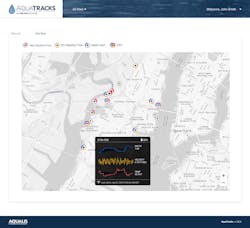How MDT Technology is Changing Storm Water
About the author:
Kara Sabatino is marketing manager for Aqualis. Sabatino can be reached at [email protected].
“Big data” is a term in the tech industry and business world, but how does it relate to storm water? Technology has changed our daily lives with almost any solution we need at the tip of our fingers. Capitalizing on emerging technology to improve storm water asset ROI and provide data to prevent storm water violations is paving a new way for innovation.
What if you could gage your water levels in your storm water system before a major rainstorm? Or receive an alert when runoff levels are higher than average?
AQUATRACKS is a network of cloud-based sensors that monitor Stormwater Control Measures’ (SCMs) health and status in real-time. Rather than implementing an inspection plan for storm water assets physically, sensors can capture data points to tell property owners or municipalities where to invest in further repairs, increased frequencies of maintenance or additional treatment measures for their storm water assets.
The Need for a Technology Solution
In the United States, 17.5% of urban areas are paved, making up 22.4 million acres, which translates to 23 trillion gallons of storm water runoff. And, those numbers continue to rise at an alarming pace. Through further urban development, which increased 22% from 2000 to 2010, and rainfall increases in the last 20 years, storm water management is more critical than ever. How do we adapt the aging infrastructure to fit in the 21st century? Technology can help.
Managing Aging Infrastructure
Storm water and wastewater infrastructure in the United States, particularly along the East Coast, have pipes more than 100 years old, far past their useful life. Cities, towns and businesses report that water regulations represent some of their costliest capital infrastructures each year. Many sectors, including commercial and municipal, have adopted the "run-to-fail" method, allocating dollars to emergency response and rehabilitation, not maintenance. Data indicates sewer system assets that are not regularly maintained usually deteriorate at a higher rate and have life cycle costs substantially higher due to repairs. Generally, for every $1 spent on maintenance, $4 in cost savings and loss avoidance can be expected. Understanding and predicting when and how a storm water asset needs maintenance is beneficial to allocating dollars to specific assets, producing effective maintenance schedules and encouraging best practices for storm water system repairs and replacements.
AQUATRACKS is designed to evaluate the entire storm water system with water depth measurements, velocity and temperature captured every five minutes. Maintenance is streamlined based on system performance, as indicated by the monitoring sensors. Actively seeing the improvements after a maintenance visit or repair allows for better cost allocations for similar systems. Replication in the treatment of similar systems allows for scalability for municipalities as well as commercial property owners.
Commercial Impacts
Increased urban development has produced more paved roads and housing developments as well as created an influx of retail storefronts. The average big box store is larger than about 12 football fields, and a 1- inch rainstorm generates more than 1 million gallons in storm water runoff. Flooding can be detrimental to a retail store, and it is not only a large rain event or hurricane that can impact brick and mortar locations. A summer rainstorm can easily cause a back-up in systems that produce flooding, closing stores, costing the retailer emergency response and lost sales.
Live data tracking can help avert a disaster for commercial properties before a rainstorm occurs. AQUATRACKS’ proprietary algorithms pair data from sensors with local weather data. Monitoring outflow and fluctuations in water levels helps predict any back-ups due to a significant rain event and allows for preventive maintenance visits to mitigate flooding and store closures for retail owners, saving thousands annually. AQUATRACKS’ dashboard allows users to easily monitor these measurements directly from a computer, tablet or smartphone. With the AQUATRACKS system, inclusive of a preventative maintenance program, many major repairs can be avoided by identifying deficiencies early, leading to significant cost savings long-term.
Keeping Up with Compliance
Storm water assets require more than just inspections and compliance, including proper monitoring and maintenance schedules for cost mitigation for property owners and local governments. AQUATRACKS provides site management and access to data that is required to pass inspections. Sensors identify sediment build-up in systems or the presence of a back-up that could lead to a failed inspection or a costly Notice of Violation (NOV). AQUATRACKS provides value, especially for troublesome systems that routinely malfunction or have high emergency response costs. The system not only helps mitigate costly repairs but also supports storm water system compliance, specifically for systems that routinely have issues meeting local regulations.
Capturing the Whole Picture
Data drives budgeting, decision-making and scaling operations, so why not bring that to storm water? Providing data to commercial property owners and municipalities can provide accurate budgeting and standardization of maintenance on similar storm water assets. Data is power and offers ROI analyses to drive improvements to aging infrastructure. Identifying an issue before back-up, flooding or high concentrations of pollutants impacts businesses or personal properties. AQUATRACKS can detect a problem and further define the source of the concern before a major repair or rehabilitation of a storm water system is needed. It can also help identify any potential issues prior to a rain event so that proper preventative maintenance can occur before the storm makes landfall.
AQUATRACKS networked sensors are just the beginning of manufactured tracking devices in the storm water industry. As data is collected, year-over-year comparisons and system assessments will assist clients and storm water management organizations in making improved decisions on repairs, when new infrastructure should be introduced and recommendations for standardization that increase ROI.


